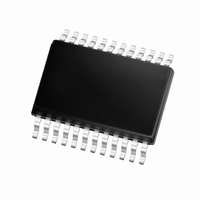MCP3909-I/SS Microchip Technology, MCP3909-I/SS Datasheet - Page 89

MCP3909-I/SS
Manufacturer Part Number
MCP3909-I/SS
Description
IC POWER METERING-1 PHASE 24SSOP
Manufacturer
Microchip Technology
Datasheets
1.MCP3909T-ISS.pdf
(44 pages)
2.MCP3909T-ISS.pdf
(104 pages)
3.MCP3909-ISS.pdf
(40 pages)
Specifications of MCP3909-I/SS
Package / Case
24-SSOP (0.200", 5.30mm Width)
Input Impedance
390 KOhm
Measurement Error
0.1%
Voltage - I/o High
2.4V
Voltage - I/o Low
0.85V
Current - Supply
2.3mA
Voltage - Supply
4.5 V ~ 5.5 V
Operating Temperature
-40°C ~ 85°C
Mounting Type
Surface Mount
Meter Type
Single Phase
Operating Temperature Range
- 40 C to + 85 C
Mounting Style
SMD/SMT
Supply Voltage Range
4.5V To 5.5V
Digital Ic Case Style
SSOP
No. Of Pins
24
Interface Type
Serial, SPI
Supply Voltage Max
5.5V
Rohs Compliant
Yes
Lead Free Status / RoHS Status
Lead free / RoHS Compliant
For Use With
MCP3909EV-MCU16 - EVALUATION BOARD FOR MCP3909MCP3909RD-3PH1 - REF DESIGN MCP3909 3PH ENGY MTR
Lead Free Status / Rohs Status
Lead free / RoHS Compliant
Available stocks
Company
Part Number
Manufacturer
Quantity
Price
Part Number:
MCP3909-I/SS
Manufacturer:
MICROCHIP/微芯
Quantity:
20 000
C.6
© 2009 Microchip Technology Inc.
IMPROVING MEASUREMENT PRECISION OF QUASI-SYNCHRONOUS
SAMPLING ALGORITHM
When using the quasi-synchronous sampling method for harmonic analysis and
calculation of power as well as voltage and current, strict restrictions apply for the
algorithm and compensation, (i.e., the frequency offset must not exceed 1% of the
central frequency). Precision of the result increases as the frequency offset gets less.
Measurement accuracy is not guaranteed, if this condition can not be met. Figure C-4
shows the quasi-synchronization algorithm using 3 iterations with input signal ranging
from 47.5 Hz to 52.5 Hz. The algorithm is for calculating the active power, the reactive
power and the relative error of current and voltage. Figure C-4 shows that the algorithm
works well when the frequency falls in the range of 47.5 Hz to 52.5 Hz. As the
frequency deviates from the range, the error increases significantly. Therefore, the
algorithm needs to be improved to fit into more applications with a more relaxed
restriction.
FIGURE C-4:
The quasi-sync sampling algorithm has relative high accuracy in frequency measure-
ment and the error can be less than 0.005 Hz. If the frequency range to be measured
can be segmented to make the frequency input closest to the multiple of cycle point,
and processed using appropriate quasi-sync window function and sine/cosine tale,
then the algorithm can be used for a much wider range of frequency .
Figure C-5 is the error analysis of the improved 3-iteration quasi-synchronous
algorithm at 3.2 ksps. It shows that the relative error for each result can be well
controlled when the frequency of the input signal falls in the range of 47.5 Hz to
52.5 Hz.
Figure C-5 clearly shows that the relative errors of the current, voltage, active power
and reactive power in the entire frequency range are less than 0.08%. Also, when the
input frequency is around the multiple of cycle frequencies (52.459 Hz, 51.613 Hz,
50.794 Hz, 50.0 Hz, 49.231 Hz, 48.485 Hz and 47.761 Hz), the calculateion error is
Quasi-sync Algorithm Error Analysis of 3 Iterations.
Power Calculation Theory
DS51723A-page 89













